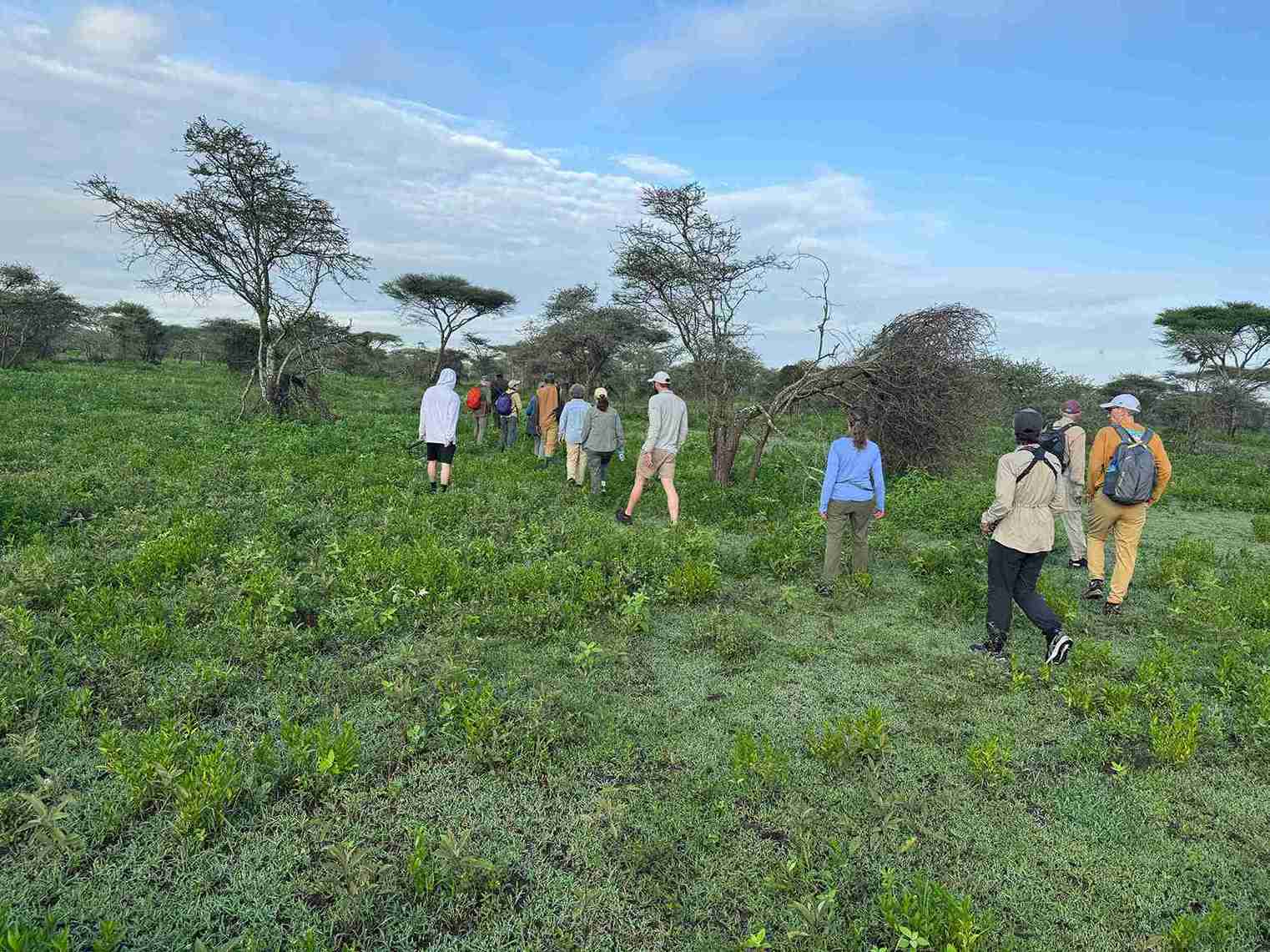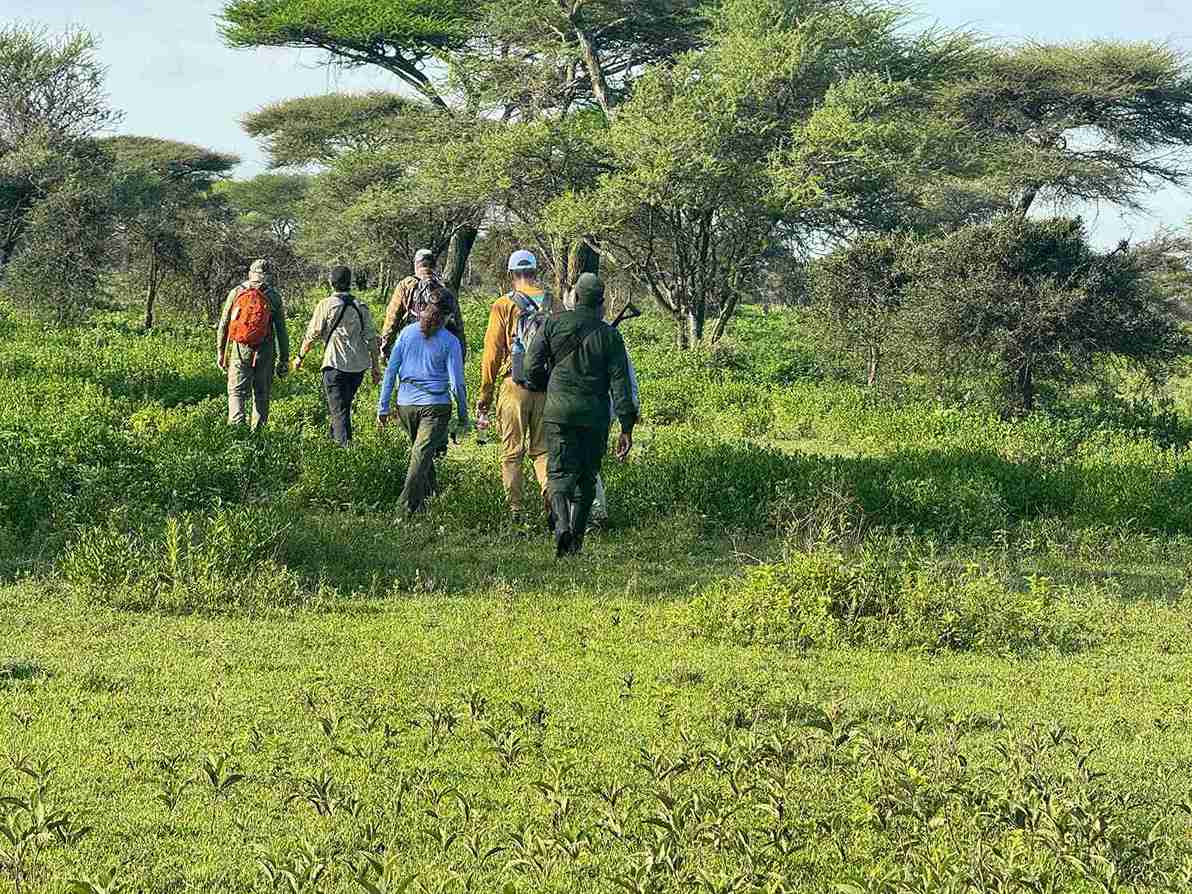Serengeti national park
Discover the iconic Serengeti National Park, Tanzania
Embark on a journey to the iconic Serengeti National Park in Tanzania. This vast expanse of wilderness is renowned for its breathtaking landscapes and unparalleled wildlife encounters. Experience the thrill of witnessing the Great Migration, where millions of wildebeest and other animals traverse the plains in search of greener pastures. Encounter the Big Five – lions, elephants, buffaloes, leopards, and rhinos – as well as a myriad of other fascinating species in their natural habitat. Immerse yourself in the beauty of the Serengeti’s sweeping savannahs, acacia-dotted plains, and winding rivers, and create unforgettable memories that will last a lifetime.
Where is the Serengeti National Park located?
What are the main attractions of the Serengeti National Park?
Embark on an unforgettable journey through Tanzania’s Serengeti National Park, where iconic attractions await at every turn. Witness the awe-inspiring Great Migration, a spectacle of millions of wildebeest and zebras traversing the plains, accompanied by prowling predators. Encounter Africa’s legendary Big Five – lions, elephants, buffaloes, leopards, and occasionally rhinos – amidst the park’s sweeping grasslands. Delight in the diverse wildlife that calls the Serengeti home, from graceful giraffes to majestic cheetahs and myriad bird species. Rise above it all on a dawn balloon safari, soaking in panoramic views of the savannah below. Immerse yourself in the park’s rich cultural heritage by engaging with Maasai communities and learning about their traditional way of life. Explore the Serengeti’s varied landscapes, from open plains to rocky outcrops, each offering unique wildlife encounters. With its blend of natural wonders and cultural treasures, the Serengeti beckons as a must-visit destination for adventurers and wildlife enthusiasts alike.
- Great Migration This annual phenomenon sees millions of wildebeest, zebras, and gazelles traverse the Serengeti in search of fresh grazing grounds. It’s a spectacle of movement, drama, and survival, with predators like lions and crocodiles waiting in ambush along the way. The exact timing and route of the migration vary each year, but witnessing this natural spectacle is a highlight for visitors to the Serengeti.
- Big Five The term “Big Five” originally referred to the five most challenging animals to hunt on foot in Africa. Today, it represents some of the continent’s most iconic wildlife species. In the Serengeti, you can see lions lounging in the shade, elephants roaming the plains, herds of buffaloes grazing, elusive leopards draped over tree branches, and occasionally spot rhinos, particularly in the Moru Kopjes area.
- Serengeti Plains: The vast grasslands of the Serengeti provide an iconic African landscape. These plains are not only visually stunning but also home to an abundance of wildlife. They offer uninterrupted views of the horizon, providing ample opportunities for wildlife sightings, especially during the Great Migration.
- Serengeti Wildlife: Beyond the Big Five, the Serengeti is home to a diverse array of wildlife. Giraffes gracefully browse the treetops, hippos wallow in muddy pools, crocodiles lurk in rivers, cheetahs sprint across the plains, and a multitude of bird species fill the skies. The park’s diverse habitats support a rich variety of fauna, making every game drive an adventure.
- Balloon Safaris: A hot air balloon safari offers a unique perspective of the Serengeti’s vast landscapes and abundant wildlife. Drifting silently over the plains at dawn, you’ll witness the awakening of the savannah below as the sun rises, casting a golden glow over the landscape. It’s a peaceful and exhilarating way to experience the Serengeti from above.
- Serengeti Visitor Centers: The park’s visitor centers provide valuable information about its ecosystems, wildlife, and conservation efforts. They often feature educational displays, interactive exhibits, and knowledgeable staff who can enhance your understanding of the Serengeti’s natural and cultural heritage.
- Cultural Encounters: Visiting local Maasai communities offers insight into traditional East African culture. You can learn about Maasai customs, traditions, and daily life, including herding cattle, constructing traditional dwellings (manyattas), and performing traditional dances. It’s an opportunity to connect with the people who have coexisted with wildlife in the Serengeti for centuries.
- Landscape Diversity: The Serengeti’s varied landscapes provide habitats for a wide range of species. From the open plains favored by herbivores to the rocky outcrops (kopjes) where predators lie in wait, each ecosystem supports its own unique wildlife community. Exploring these diverse landscapes adds depth to your Serengeti experience and increases your chances of encountering a wide variety of wildlife.
These attractions collectively make the Serengeti National Park one of the world’s premier wildlife destinations, offering a blend of natural beauty, cultural richness, and unparalleled wildlife experiences.
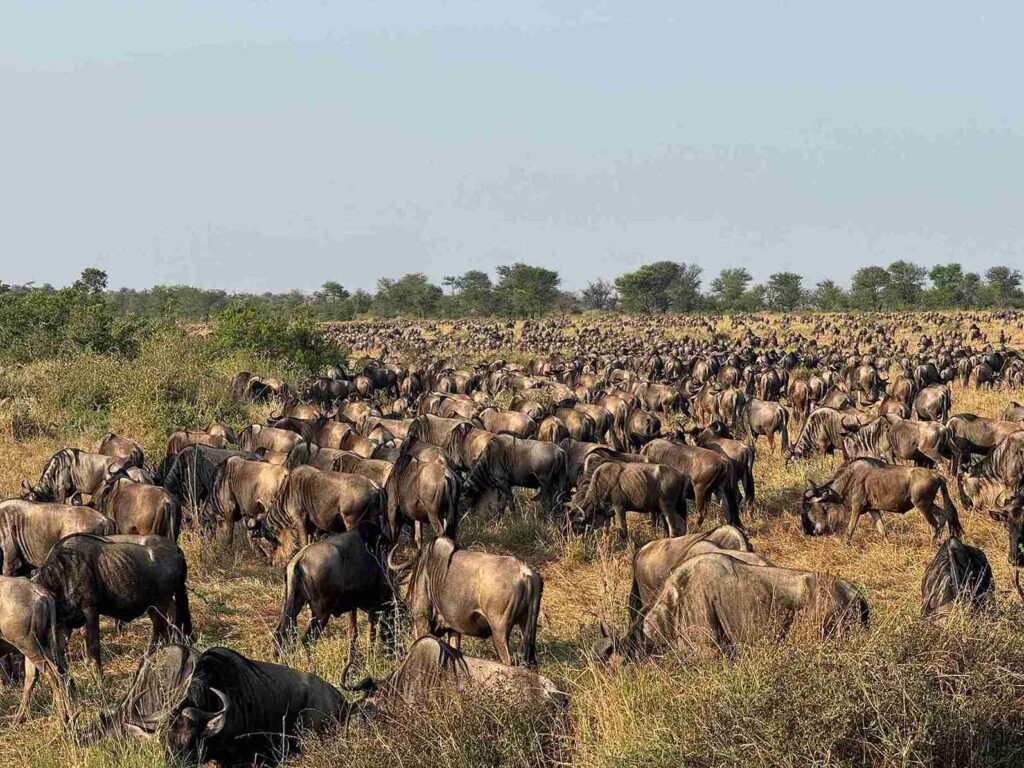
Activities in the Serengeti National Park
To elevate a classic safari experience in the Serengeti, travelers can enrich their journey with unique savanna adventures. In addition to traditional game drives, visitors can indulge in the following enhancements to their safari tour:
Hot air balloon safari
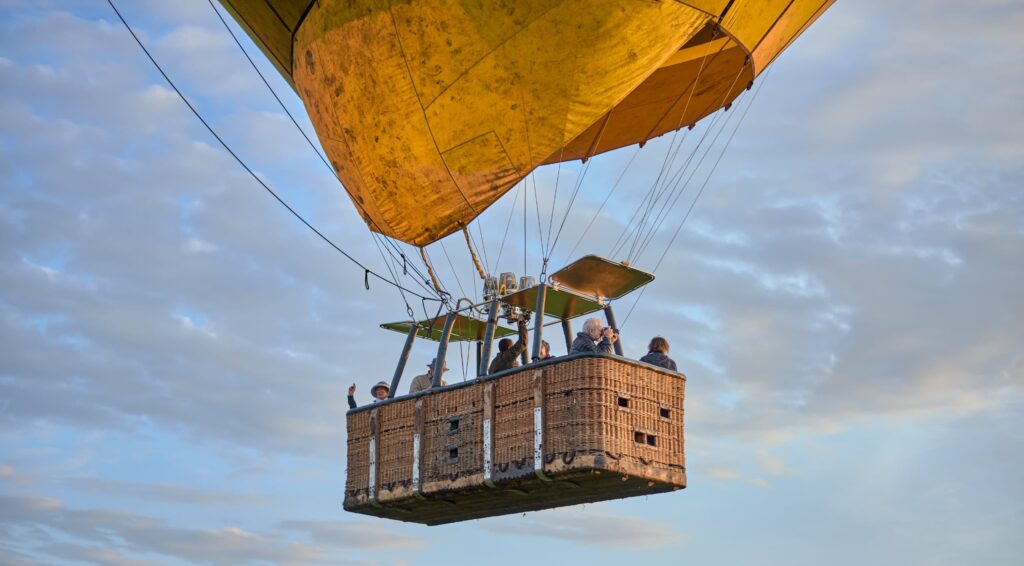
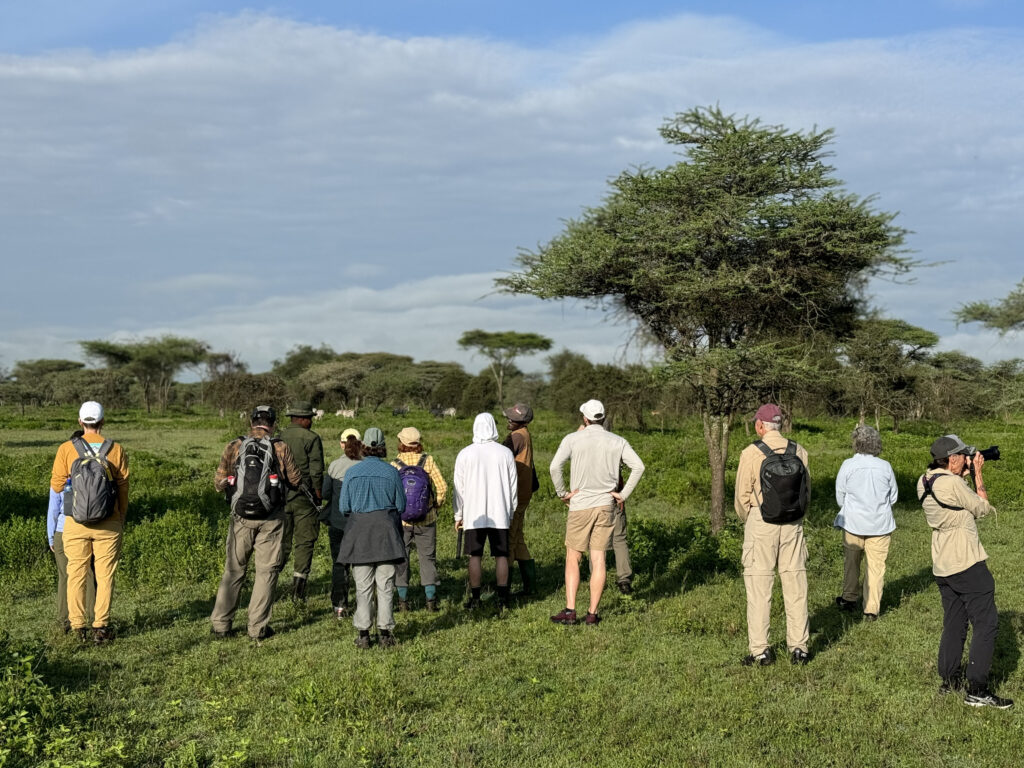
Walking Safari
Lace up your boots and embark on a walking safari led by knowledgeable guides who will share their expertise about the local flora, fauna, and ecosystem. Walking safaris offer a more immersive and intimate experience compared to traditional game drives, allowing you to engage all your senses as you explore the wilderness on foot. You’ll have the opportunity to track animal footprints, identify bird calls, and learn about the intricate relationships between different species. It’s a chance to slow down, connect with nature, and appreciate the smaller details that often go unnoticed from a vehicle.
Cultural Interaction
The Serengeti is not only home to diverse wildlife but also to vibrant indigenous communities such as the Maasai. Engaging with local tribes provides a deeper understanding of the region’s rich cultural heritage. Visitors can participate in cultural activities such as spear throwing demonstrations, traditional dances, and handicraft workshops. By interacting with community members and learning about their way of life, travelers gain insight into the symbiotic relationship between people and wildlife in this region.


Night Game Drives
As the sun sets over the Serengeti, a new cast of characters emerges under the cover of darkness. Night game drives offer a thrilling opportunity to observe nocturnal animals in their natural habitat. With the aid of powerful spotlights, you’ll search for elusive creatures such as leopards prowling through the bush, hyenas on the prowl, and bush babies leaping through the trees. The atmosphere is electric as the sounds of the night come alive, providing a completely different safari experience after sunset.
Bush Breakfasts and Sundowners
There’s something magical about dining in the heart of the wilderness as the sun bathes the landscape in warm hues. Bush breakfasts and sundowners are quintessential safari experiences that allow travelers to savor delicious meals and drinks against a backdrop of stunning scenery. Whether you’re enjoying a hearty breakfast amidst the savanna or toasting to another day of adventure as the sun dips below the horizon, these outdoor dining experiences create lasting memories of serenity and beauty in the wild.


Conservation Experiences
The Serengeti is not only a place of natural wonder but also a critical ecosystem that requires conservation efforts to protect its biodiversity. Visitors can learn about ongoing conservation initiatives by visiting research centers and engaging in hands-on activities such as tree planting or wildlife monitoring. By participating in these experiences, travelers contribute to the preservation of the Serengeti’s ecological integrity and ensure that future generations can continue to marvel at its beauty.
Photography Workshops
With its breathtaking landscapes and abundant wildlife, the Serengeti is a photographer’s paradise. Photography workshops led by professional wildlife photographers provide valuable insights and techniques for capturing stunning images of the savanna’s inhabitants. Whether you’re a beginner looking to improve your skills or a seasoned photographer seeking new perspectives, these workshops offer guidance on composition, lighting, and wildlife behavior. It’s an opportunity to hone your craft while immersing yourself in one of the most iconic safari destinations on Earth.
Each of these unique experiences adds depth and richness to a safari in the Serengeti, allowing travelers to connect with nature, culture, and conservation in meaningful ways. Whether soaring above the plains in a hot air balloon or learning about traditional Maasai customs, the Serengeti offers a tapestry of experiences that leave a lasting impression on all who visit.
History of the Serengeti National Park
The Serengeti National Park in northern Tanzania holds a rich and storied history deeply rooted in the conservation movement and the preservation of East Africa’s natural heritage. From the early inhabitants, including hunter-gatherer communities and later pastoralist tribes such as the Maasai, to the colonial era when European explorers and hunters began to venture into the region, the Serengeti has long been a place of human-wildlife interaction. However, concerns about the depletion of wildlife populations due to hunting and habitat destruction prompted action.
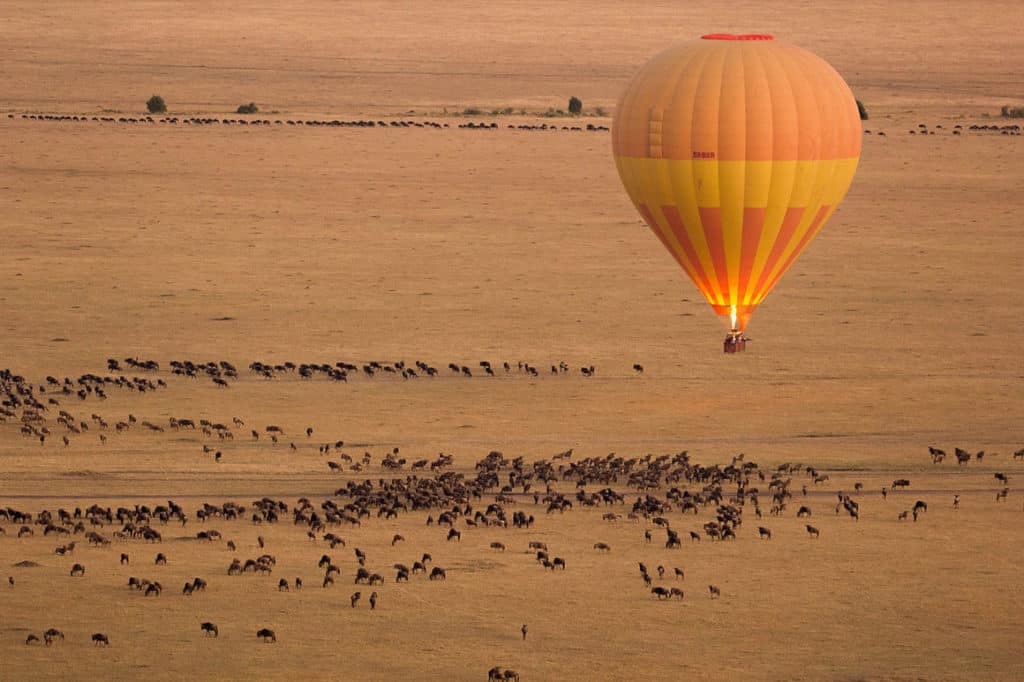
The park’s significance was further recognized in 1981 when it was designated as a UNESCO World Heritage Site, highlighting its outstanding universal value and importance for the conservation of biodiversity. Central to the Serengeti’s allure is the annual wildebeest migration, a spectacular natural phenomenon that attracts tourists from around the world and underscores the importance of preserving the park’s ecological integrity.
However, the Serengeti faces ongoing conservation challenges, including habitat fragmentation, poaching, human-wildlife conflict, and climate change. Despite these challenges, concerted efforts by conservation organizations, government agencies, and local communities aim to address these threats and ensure the long-term sustainability of this iconic wilderness. Today, the Serengeti National Park stands as a symbol of Africa’s natural beauty and biodiversity, a testament to the legacy of conservation efforts aimed at safeguarding this extraordinary landscape for future generations to cherish and enjoy.
Frequently Asked Questions about the Serengeti
The Serengeti’s expansive plains are renowned for their iconic wildlife, including large populations of herbivores such as wildebeest, zebras, and gazelles, as well as predators like lions, cheetahs, and leopards. The Great Migration, one of the most spectacular wildlife events on the planet, takes place within the Serengeti, as millions of wildebeest and other herbivores migrate in search of fresh grazing lands.
The name “Serengeti” has become synonymous with the awe-inspiring beauty and biodiversity of East Africa’s wilderness, attracting visitors from around the world to witness its natural wonders firsthand. Whether it’s the endless horizons of the plains or the mesmerizing wildlife encounters, the Serengeti continues to captivate and inspire all who venture into its boundless landscapes.
Short Visit (2-3 Days):
If you’re short on time, a two to three-day visit can still provide a rewarding safari experience in the Serengeti. During this time, you can focus on exploring specific areas of the park, such as the Seronera region (known for its resident wildlife), or participating in guided game drives to spot iconic species like lions, elephants, and giraffes. While a brief visit may limit your ability to cover the entire park, you can still enjoy memorable wildlife encounters and stunning landscapes.Standard Visit (4-6 Days):
For a more comprehensive experience, consider spending four to six days in the Serengeti. This allows you to explore a wider range of habitats and wildlife hotspots within the park, including the Seronera Valley, Western Corridor, and northern reaches near the Mara River. With additional time, you can venture off the beaten path on guided game drives, embark on walking safaris, and witness the spectacle of the Great Migration (if visiting during the appropriate season). A multi-day visit also provides opportunities for relaxation and leisure, allowing you to soak in the serenity of the African wilderness.Extended Visit (7 Days or More):
– If you have the luxury of time, consider extending your stay in the Serengeti to seven days or more. This allows for a truly immersive safari experience, with ample time to explore the park’s diverse ecosystems, observe seasonal wildlife behaviors, and venture into remote areas that are less frequented by tourists. An extended visit also offers flexibility for spontaneous game drives, photography excursions, and cultural interactions with local communities. Whether you’re a wildlife enthusiast, photographer, or nature lover, a longer stay in the Serengeti allows you to deepen your appreciation for Africa’s wilderness and create lasting memories. Ultimately, the duration of your visit to the Serengeti depends on your personal preferences and travel goals. Whether you’re planning a short getaway or an extended safari adventure, each day in the Serengeti promises unforgettable wildlife encounters, breathtaking scenery, and a deeper connection with nature.The best time to visit the Serengeti National Park depends on your interests and what you hope to experience during your safari. Here’s a breakdown of the different seasons and their highlights:
Dry Season (June to October):
- This period, known as the dry season or peak season, is generally considered the best time to visit the Serengeti for wildlife viewing. With the vegetation becoming sparse and water sources dwindling, animals gather around remaining waterholes and rivers, making them easier to spot.
- June to August: Wildlife concentrations are high, particularly in the central and western Serengeti. The Great Migration often reaches the northern Serengeti and the Mara River, offering opportunities to witness dramatic river crossings.
- September to October: The Great Migration continues its movement southward into the Serengeti’s southern plains, providing excellent game viewing opportunities. This period is also ideal for spotting predators, as they prey on weakened herbivores during the dry season.
Wet Season (November to May):
- The wet season, also known as the green season or low season, brings sporadic rainfall to the Serengeti, transforming the landscape into lush greenery. While wildlife viewing can be more challenging due to thicker vegetation and dispersed animal populations, this time offers its own unique advantages:
- November to December: The short rains begin, revitalizing the landscape and triggering the birthing season for wildebeest and other herbivores. This period offers excellent opportunities to witness newborn animals and predator action.
- January to March: The calving season peaks, with thousands of wildebeest giving birth on the southern plains of the Serengeti. This is a prime time for predator sightings as they target vulnerable young animals.
- April to May: The long rains arrive, bringing heavy downpours and transforming the Serengeti into a lush paradise. While wildlife viewing can be more challenging during this time, the landscape is incredibly beautiful, and birdwatching opportunities are excellent.
Ultimately, the best time to visit the Serengeti depends on your priorities and preferences. If you’re primarily interested in witnessing the Great Migration and optimal wildlife viewing, the dry season is recommended. However, if you’re interested in experiencing the birthing season, lush landscapes, and fewer crowds, the wet season can offer a unique and rewarding safari experience.
Interesting facts about the Serengeti National Park
The Serengeti’s expansive plains are renowned for their iconic wildlife, including large populations of herbivores such as wildebeest, zebras, and gazelles, as well as predators like lions, cheetahs, and leopards. The Great Migration, one of the most spectacular wildlife events on the planet, takes place within the Serengeti, as millions of wildebeest and other herbivores migrate in search of fresh grazing lands.
The name “Serengeti” has become synonymous with the awe-inspiring beauty and biodiversity of East Africa’s wilderness, attracting visitors from around the world to witness its natural wonders firsthand. Whether it’s the endless horizons of the plains or the mesmerizing wildlife encounters, the Serengeti continues to captivate and inspire all who venture into its boundless landscapes.
Among the most iconic and numerous animals found in the Serengeti are wildebeest, zebras, lions, elephants, giraffes, cheetahs, and buffaloes. The park is particularly famous for its massive wildebeest populations, with over a million individuals participating in the annual Great Migration, a spectacle that captivates visitors from around the world.
In addition to wildebeest, zebras play a significant role in the Great Migration, traversing the plains in search of fresh grazing alongside their herbivore counterparts. The Serengeti also boasts a healthy population of lions, with prides spread across different regions of the park, while elephants, though not as numerous, can be found in areas with suitable habitat and water sources.
Giraffes are a common sight in the Serengeti, gracefully towering over the savanna as they feed on acacia trees, while cheetahs, known as the fastest land animals, hunt across the grasslands with their incredible speed. Leopards, though more elusive, also inhabit the Serengeti, often preferring wooded areas and rocky outcrops for hunting and resting.
African buffaloes form large herds and graze on grasses in various habitats within the Serengeti, contributing to the park’s rich biodiversity. Additionally, the Serengeti is home to numerous bird species, including raptors, waterfowl, and migratory birds, adding to the park’s ecological diversity and allure.
While the exact number of animals fluctuates throughout the year due to seasonal movements and migrations, the Serengeti remains a premier destination for wildlife viewing and conservation, offering visitors unparalleled opportunities to observe and appreciate Africa’s natural wonders.


